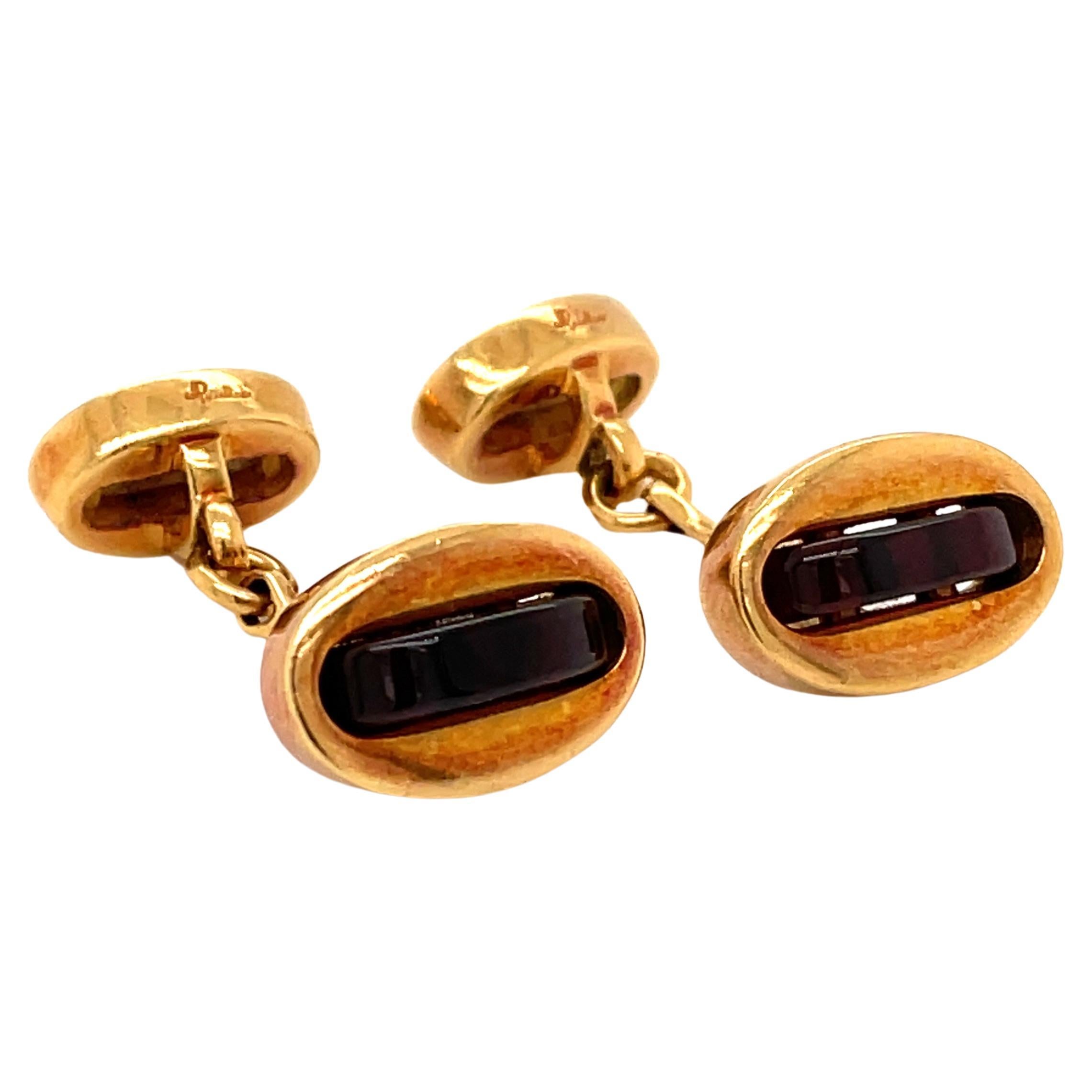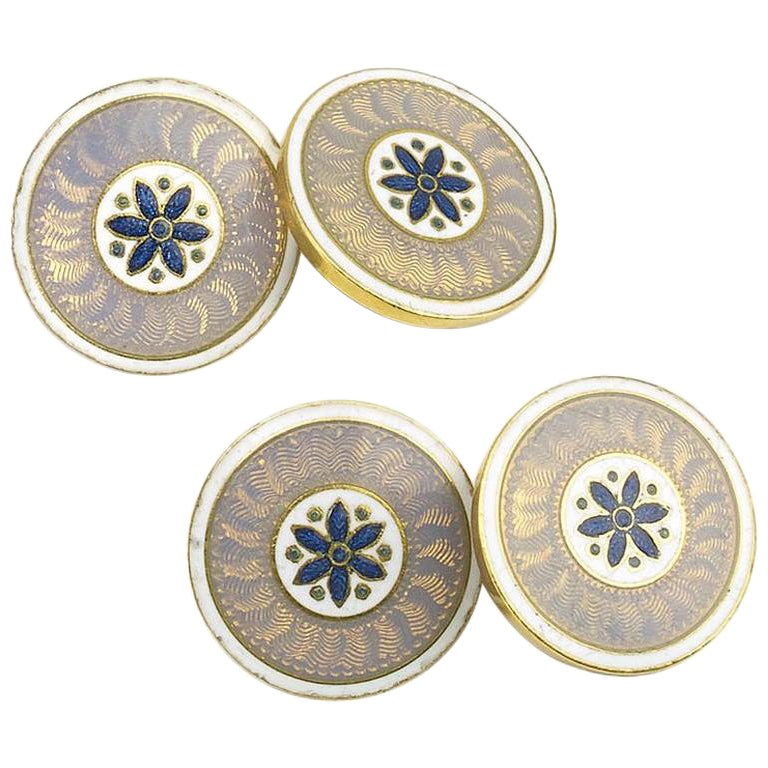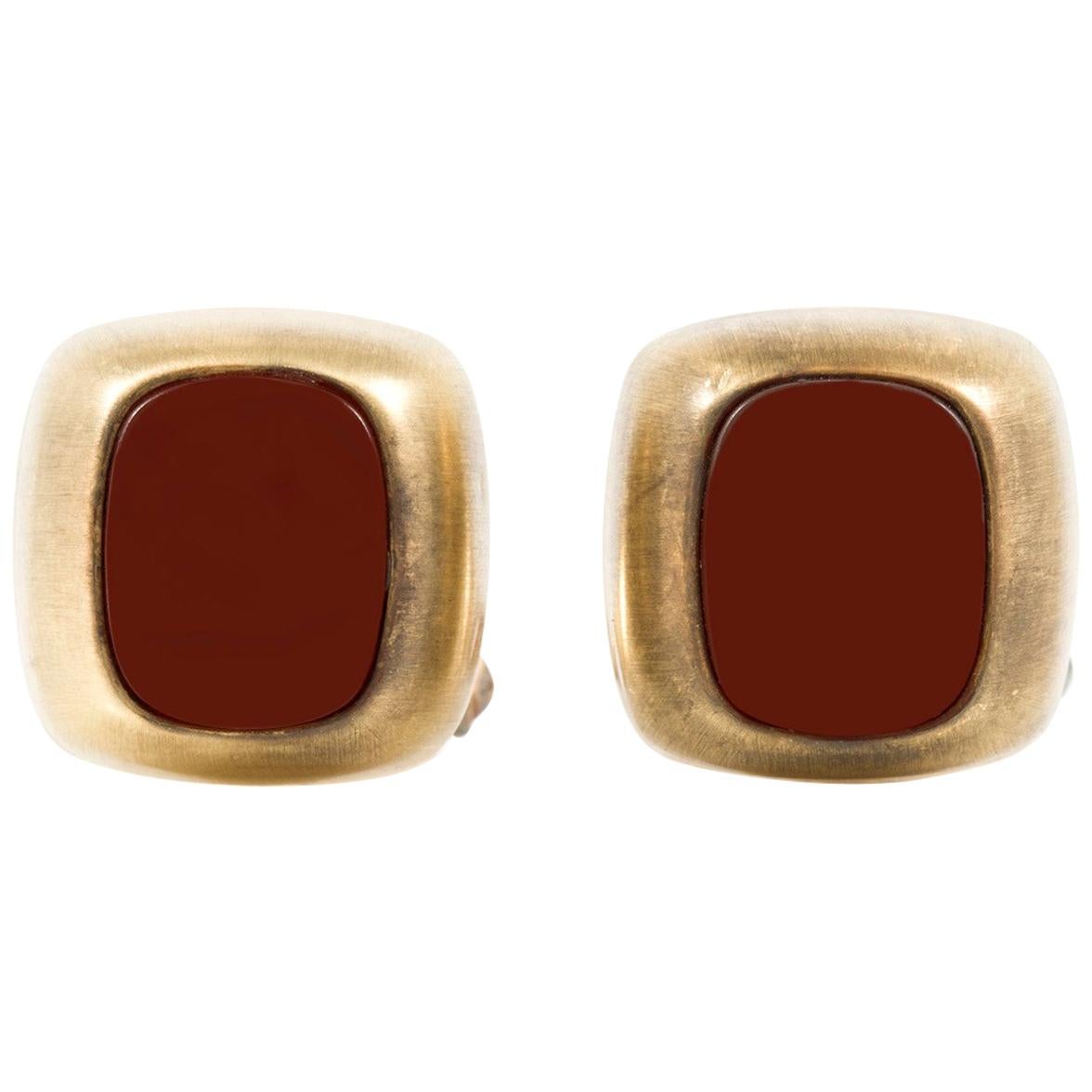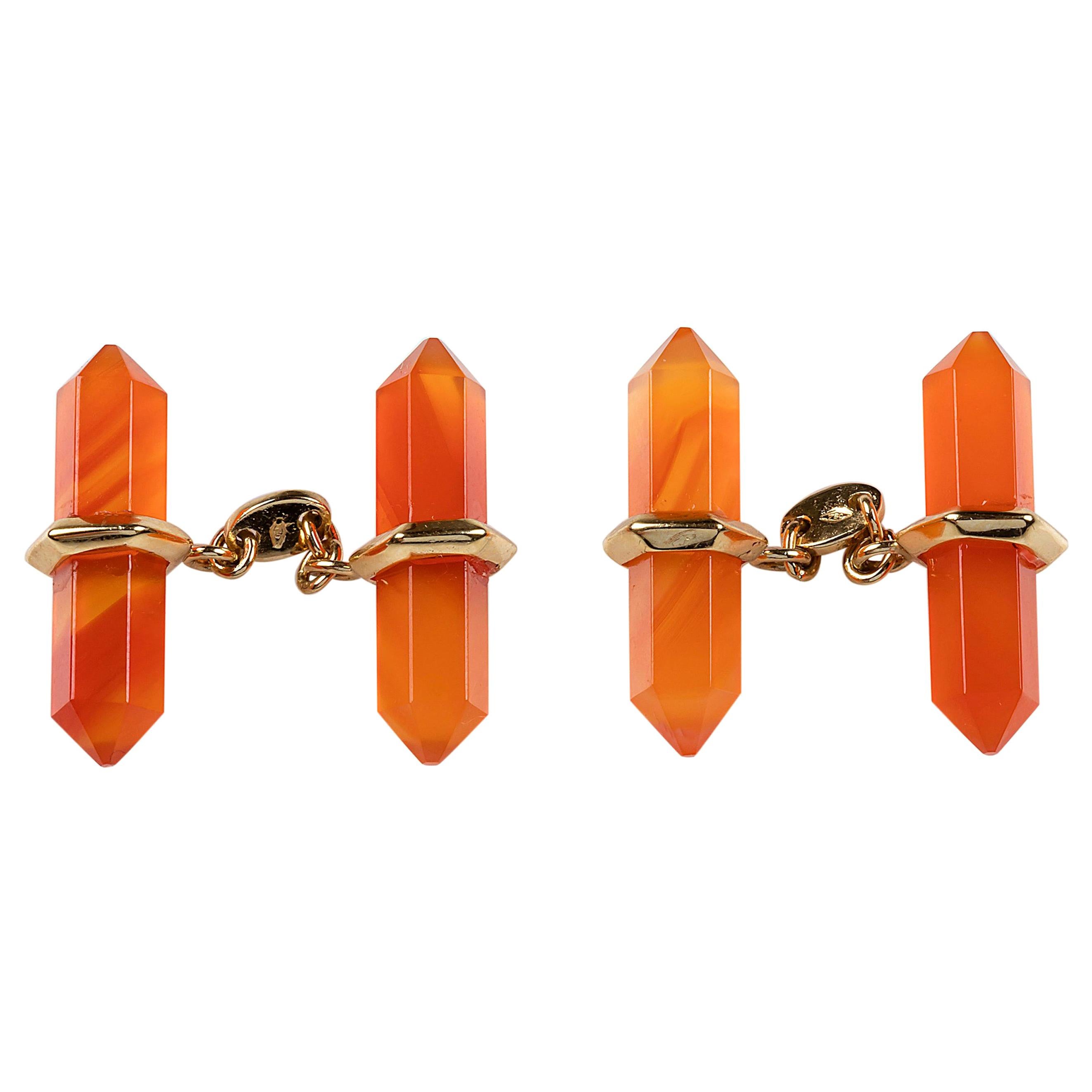Items Similar to Wiese Carnelian Intaglio Gold Cufflinks, circa 1925
Want more images or videos?
Request additional images or videos from the seller
1 of 8
Wiese Carnelian Intaglio Gold Cufflinks, circa 1925
About the Item
A pair of Wiese, intaglio cufflinks, set with cornelian intaglios, mounted in 18ct gold. The intaglios depict a child's head; the bust of a philosopher; Hygeia, the Greek goddess of hygiene, with a serpent around her neck, this intaglio is dated to circa third century A. D. and Gryllus, a Greek mythological character, who was half man, half pig, with two faces, one on his stomach; this intaglio is dated to circa second century A. D.. The cast mounts depict three rows of rope style wire twists, with a beading surround, in fine gold, with carabiner fittings, with French eagle marks, signed Wiése. Accompanied by an invoice dated 1925.
Jules Wièse is regarded as one of the finest silver and goldsmiths of the 19th Century. Born in Berlin in 1818 he became apprenticed to the court goldsmith Johann Georg Hossaeur at the age of sixteen. Not long afterwards he moved to Paris, working first for J-V Morel before settling in a position with the renowned jewellers Froment-Meurice in 1839. He quickly rose to become workshop manager, tripling his wage in the process, before deciding that further financial gains could be made by setting up his own workshop which he did in 1845 at number 7, rue Jean-Pain-Mollet. To begin with he worked exclusively for his former employer who recognised his invaluable contribution at the 1849 Paris Exposition by ensuring that Wièse was awarded a collaborators medal. By the time of the next Paris fair six years later, Wièse was exhibiting under his own name having registered his makers mark some years previously. This consisted of his initials JW with a star above and below within a vertical lozenge it was registered in 1844 and remained in use for the next forty six years. The exposure he gained at this fair won him a significant and widely appreciative audience, including his peers and the judges, who awarded him a First Class medal for his work, commending him on his “excellence as a modeller and inventor”. On seeing his display stand, Wièse’s contemporary M. Magne wrote that he was a “fine goldsmith and jeweller with an already distinguished reputation… the importance of his pieces and his brave experiments reveal, even in the most modest work, an awareness of art and beauty which deserves to be encouraged….” He continued to produce both jewellery and other items such as mirrors, knives and goblets in the Neo-Renaissance style for many years, winning further medals in Paris and London, and securing various commissions including one from the city of Autun for a decorative presentation sword. His work was highly sculptural, often featuring figures which could be either human or mythological in nature, many with a definite Gothic overtone. In 1880 his son Louis (1852-1923) assumed control of the workshop having been trained by his father and when Jules died ten years later, Louis registered his own makers mark - the name WIESE with a star above and one below in a horizontal lozenge. Described by Vever as “an exceptionally modest and truly talented artist” Louis sought to continue the exemplary reputation for fine craftsmanship that his father had earned during his career. He continued working in the same tradition, producing beautifully crafted goldwork (sometimes to his father’s designs) which explored the familiar themes of the Neo-Renaissance and Gothic imagination whilst also looking to religion and archaeology to inspire him. He frequently employed grotesque beasts and gargoyles, ecclesiastic detailing and historic influences. If gems were used he would typically set them using antique-inspired methods and he was also known to use mercury oxide to distress the surface of metal, further enhancing the ‘aged’ appearance of his jewels. Enamelling was used to introduce colour and add another dimension to his pieces which are still highly regarded today and collected by a discerning group of individuals including contemporary goldsmiths. Examples of Wièse jewellery can be found in major museums worldwide including the British Museum and the Musée des Arts Décoratifs in Paris.
- Creator:
- Metal:18k Gold
- Stone:Carnelian
- Stone Cut:Oval Cut
- Weight:30 g
- Style:Greek Revival
- Place of Origin:France
- Period:1920-1929
- Date of Manufacture:Circa 1925
- Condition:Wear consistent with age and use.
- Seller Location:London, GB
- Reference Number:
About the Seller
4.9
Recognized Seller
These prestigious sellers are industry leaders and represent the highest echelon for item quality and design.
Gold Seller
These expertly vetted sellers are highly rated and consistently exceed customer expectations.
Established in 1970
1stDibs seller since 2015
118 sales on 1stDibs
Typical response time: 5 hours
- ShippingRetrieving quote...Ships From: London, United Kingdom
- Return PolicyA return for this item may be initiated within 7 days of delivery.
More From This SellerView All
- Cartier Art Deco Enamel Gold Cufflinks, circa 1925By CartierLocated in London, GBA pair of Art Deco Cartier enamel cufflinks, with a central dark blue, guilloche enamel flower, with green guilloche enamel dots, between the petals, on a white enamel background, su...Category
Vintage 1920s French Art Deco Cufflinks
Materials18k Gold, Enamel
- Enamel Gold Cufflinks, circa 1950Located in London, GBA pair of vintage enamel and gold cufflinks, circular in shape, with yellow and blue enamel in an abstract design, on 14ct yellow gold, with ba...Category
Vintage 1950s Cufflinks
Materials14k Gold
- Webb Gold Horse Cufflinks, circa 1960By David WebbLocated in London, GBA pair of vintage gold horse cufflinks, by Webb, with horse heads surmounted on horseshoes, with nails as bars. Signed Webb. Circa 1960.Category
Vintage 1970s British Cufflinks
MaterialsYellow Gold
- Antique Gold Frog Cufflinks, circa 1900Located in London, GBA pair of antique gold frog cufflinks, with models of frogs on oval back plates, with a wire twist within the surround, mounted in gold with a numbered mark, and twisted bar fittings...Category
Early 20th Century British Edwardian Cufflinks
Materials15k Gold
- Gold Reversible Diamond Swivel Cufflinks, circa 1920Located in London, GBA pair of reversible gold cufflinks, set with a line of rose-cut diamonds, in grain settings, on oval, convex, hollow work heads, with solid swivel links, marked RGD 14856, 750, with...Category
Vintage 1920s French Art Deco Cufflinks
MaterialsDiamond, 18k Gold
- French Gold Spring Stirrup Cufflinks, circa 1950Located in London, GBA pair of vintage French gold stirrup cufflinks, with the body forming a heavy gauge wire spring, with double gold disc terminals and bar fittings. The spring aids the opening mechan...Category
Vintage 1950s French Cufflinks
Materials18k Gold
You May Also Like
- Pomellato Carnelian Gold CufflinksBy PomellatoLocated in Napoli, ItalyNice vintage Italian Pomellato Cufflinks, made of solid 18k yellow gold and set with Carnelians Metal: 18k yellow gold Signature: Pomellato Gross Weight: 15 grams Excellent conditi...Category
Late 20th Century Italian Cufflinks
MaterialsCarnelian, 18k Gold, Gold, Yellow Gold
- Carnelian CufflinksLocated in New York, NYCarnelian cufflinks finely crafted in 14k yellow gold.Category
20th Century German Cufflinks
Materials14k Gold
- Cameo Carnelian Cufflink 18 Karat GoldBy Giulia ColussiLocated in Milan, ITAntiques cameo carved Carnelian cufflinks 18 Kt Gold gr. 14,40. measures 1,5x 1,00 cm. All Giulia Colussi jewelry is new and has never bee...Category
2010s Italian Artisan Cufflinks
MaterialsCarnelian, 18k Gold, Gold
- 18 Karat Yellow Gold Cufflinks CarnelianBy AVGVSTALocated in Milano, ITThese timeless cufflinks are minimalist and elegant. Their front face and toggle is identically shaped as an elongated hexagon made of carnelian. The warm red of the stone perfectl...Category
2010s Italian Contemporary Cufflinks
MaterialsCarnelian, 18k Gold, Yellow Gold
- Kieselstein-Cord Gold Cufflinks Intaglio GlassBy KIESELSTEIN-CORDLocated in Beverly Hills, CAA pair of Kieselstein-Cord 18k gold cufflinks. Cufflinks feature intaglio carved on red glass portraying Medusa figure. The faces are oval, with bezel set glass. The cufflinks are collectible and suitable for both men and women. About Kieselstein-Cord brand Prior to start designing jewelry, Barry Kieselstein-Cord was an acclaimed photographer and art director. He developed his interest in metal colors while being in his teens and experimenting with patina and hues. He worked for Georg Jensen for a few years and established his own brand in 1972. Besides jewelry, Kieselstein-Cord designed accessories and home furnishing. Later he added bags to his collection. First success came to the brand’s silver pieces. In the late 1907s Barry Cord...Category
Vintage 1980s Cufflinks
MaterialsGold, 18k Gold, Yellow Gold
- 18 Karat Rose Gold Carnelian Diamond CufflinksBy Vitale 1913Located in Monte-Carlo, MC18K rose gold "Wall street" unique cufflinks are from Divine Collection. These classy cufflinks are made from beautiful natural carnelian 20.0 Carat and natural white diamonds in tot...Category
2010s Italian Contemporary Cufflinks
MaterialsDiamond, White Diamond, Carnelian, 18k Gold, Rose Gold
Recently Viewed
View AllMore Ways To Browse
Gargoyle Head
Wiese Jules
Wiese Louis
1920 Gothic Jewelry
Initial V Gold Antique
Gothic Initials
Goddess Intaglio Carnelian
Holland Cufflinks
Ivory Cufflinks
Mens Vintage Stud And Cufflink Sets
Piano Cufflinks
Pisces Cufflinks
Tiffany Jade Cufflinks
Tiffany Single Cufflinks
Tortoise Cufflinks
Vintage Ivory Cufflinks
White Gold Sapphire Tuxedo
14k Cufflinks Batons





